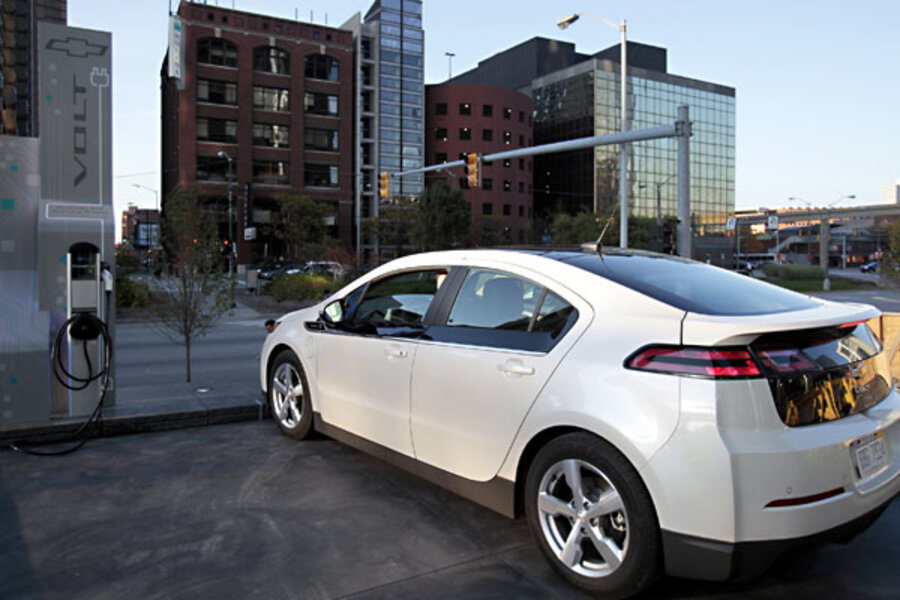Chevy Volt: GM's loss leader under new scrutiny
Loading...
General Motors is years away from making money on the Chevy Volt, its electric plug-in hybrid. And a new report suggests that Chevy loses up to $49,000 on every Volt it produces.
But that doesn't mean that the car is necessarily a dud for GM. In the long term, GM's big technology bet could still turn out to be a winner, while the disparity between the Volt's costs and its revenues have been exaggerated by a short-term promotion.
During a Chevy summer promotion that ended Sept. 4, a potential driver could sign a contract to lease a Volt for $279 a month, sometimes $199 or less. That meant customers could lease a Volt for around $5,000 over two years, driving a car that costs several times that to produce.
“The lease deals are amazing and making this car really affordable for a lot of people” says Bradley Berman, a writer and green car industry research expert who contributes to the New York Times, Reuters, and others. “But it’s temporary discounting, and I don’t know what GM’s long-term pricing strategy is. If you keep lowering the price, there can be a lot of problems for that car.”
The focus on the Volt's production costs has intensified since a Reuters report suggested that Chevrolet, a division of General Motors, spends an estimated $75,000 to $88,000 to built a Volt. The base price of the 2013 Volt is right around $40,000. Thus, GM could be losing up to $49,000 on every Volt it sells.
The report has generated plenty of push-back. Critics say it contains fuzzy math and point out that investment in new technologies doesn’t pay off right away. It took Toyota over a decade, for instance, to see a profit from the hybrid Prius, first launched in Japan in 1997.
The Volt's price has been the subject of much sniping since its release in 2010. Like many alternative energy options for consumers, the costs for electric and hybrid vehicles are heavy up-front. The Volt costs about two and a half times as much as a conventional-engine Chevy Cruze compact, which has the same body model.
But the Volt's strong suit – and the focus of Chevy’s initial sales pitch – is how cheap it is to operate after the sale. The 2012 model can go 35 miles on an electric charge alone before switching over to gasoline, which means that many commuters will rarely have to buy gas, if ever. The new 2013 model bumps that electric-only range up to 38 miles.
Another negative: Sales have not been great. That's one reason the Volt is so costly to manufacture. GM can't spread its fixed production costs over hundreds of thousands of cars. Last month, the Volt set a new sales record – 2,831 units – which may have been helped by the super low leasing promotion in August. That pushes 2012 sales to about 13,500, still well below the pace needed to meet GM’s sales goal of 40,000 for the year.
Such deep discounting is a telling sign within the industry that an automaker is having trouble moving cars, says Mr. Berman. But quibbling over the Volt’s month-to-month sales figures misses the larger point: Things are looking up. “There’s nothing wrong with the volume they’ve managed in the last few months, and it’s on an upward trajectory,” he says. “Anytime you have a model year upgrade, there are going to be irregularities in sales and pricing. It’s too early to pronounce it either a great success or failure.”
He adds that plug-in hybrids in particular are gaining a foothold in the US market, especially over pure plug-in models like the Nissan Leaf. It’s partially because of “range anxiety,” where drivers fear getting stranded without a charge in electric vehicles, and partially because the Volt is just plain fun to drive. “A lot depends on the design of the car, creature comforts, and drive performance.”
Until that market foothold starts translating to profits, the Volt does offer GM something perhaps even more valuable: It casts the Chevy brand and GM generally in an environmentally responsible light, luring to showrooms a new batch of potential customers who might know Chevy mainly as a purveyor of gas-guzzling trucks.
“Every automaker wants a halo car, and Chevy clearly sees [the Volt] as that,” Berman says. “Just see how much they’re advertising the Volt. The advertising dollars spent are vastly disproportionate for the Volt compared to its sales, because it’s a demonstration that GM can produce the most advanced high-tech energy cars out there. That has huge brand benefits.”
The ideal halo car, of course, is Toyota’s Prius, which sells well and is more affordable, thus far, than the Volt. Toyota sold 21,111 Priuses in August 2012, 15 years after the car's debut. Total sales for all Prius models are nearing 3 million. The two-year-old Volt likely has some time before it will be expected to make the same kind of impact.






